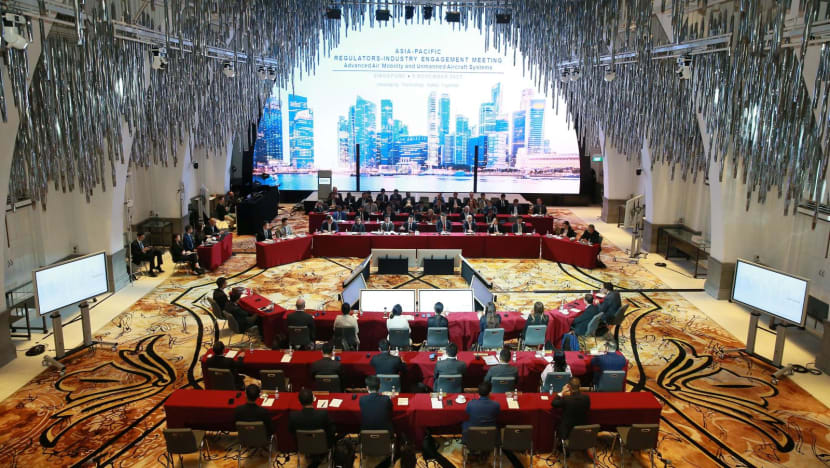Singapore aims to become base for air taxi firms; CAAS working with regional counterparts on guidelines
Regional aviation authorities aim to come up with a set of reference materials by 2025 that each country can adopt to govern air taxi and drone operations.

A Volocopter air taxi performs a demonstration in Singapore, Oct 22, 2019. (Photo: REUTERS/Feline Lim)

This audio is generated by an AI tool.
SINGAPORE: Singapore is looking to become a base for air taxi companies to operate in, with the Civil Aviation Authority of Singapore (CAAS) working closely with other regional authorities to prepare guidelines for the use of air taxis.
With the technology taking off around the world, Singapore initiated the first meeting of Asia-Pacific regulators on advanced aircraft mobility and unmanned aircraft systems on Thursday (Nov 9).
The meeting, which sought to foster collaboration and pool resources to mitigate risks, was attended by representatives from 17 civil aviation authorities from the region, including from China, India, Japan, New Zealand and Papua New Guinea.
They aim to come up with a set of reference materials by 2025 that each country can adapt and use to govern air taxi and drone operations.
This comes as air taxis and drones are expected to transform the way people work, move and live.
In Europe, for instance, authorities are already working to certify air taxis safe to serve passengers at the Paris Olympics next year.
Air taxis are small aircraft that can make short flights.
COMING UP WITH GUIDELINES FOR AIR TAXI, DRONE OPERATIONS
CAAS director-general Han Kok Juan, who chaired the inaugural meeting, said regulators need to keep pace with technology to reap its full benefits, while ensuring security as well as public and aviation safety.
“This is challenging, given the novelty of the technology, the speed of development and adoption, and resource constraints and competing priorities,” he noted.
Some air taxi companies may want to use Singapore as a base “for them to set up business as well as to operate air taxis in and out of Singapore”, he added.
“Our collaboration with these other countries would allow us to better understand the requirements, and subsequently support such applications.”

At the meeting, the regulators noted that the two priority areas for drones are technical guidance and personnel training, such as the qualifications needed for personnel to use the guidance materials.
For air taxis, they highlighted six priorities including certification, cooperation between national agencies, regulations for commercial activities and public education to promote acceptance.
A total of 24 private-sector institutes and companies also shared their views with regulators at the meeting.
Aerospace manufacturer Vertical Aerospace said it already uses Singapore as its base to enter markets in the region.
“We have pre-sold 1,500 aircraft, of which one-third … are located in the APAC region,” said Mr Derek Cheng, head of commercial (Asia-Pacific) at Vertical Aerospace.
“We believe that Singapore - being in the centre of APAC - has a great potential to play a role to not just support the aircraft into its entry into service, but extend its leadership position in the MRO (maintenance, repair, and overhaul) sector, as well as the supply itself in terms of adopting these new technologies.”
HOW POPULAR WILL AIR TAXIS BE IN FUTURE?
Dr Terence Fan, assistant professor of strategy and entrepreneurship at the Singapore Management University (SMU), said: “On the leisure side of things, there's always some interest in riding these air taxis for people viewing scenic spots.
“For Singapore actually, there's quite a bit of a skyline. Certainly, we can have air taxis as another way for people to view the city.”
From the business needs perspective, air taxis are usually used for less-served destinations, he told CNA’s Singapore Tonight on Thursday.
“In Singapore overall, I'm afraid we're quite built-up. So, there aren't many remote destinations that are difficult to reach. But we can certainly still see air taxis as a way to sort of bypass congested areas.”
The use of air taxis would be more likely in “other metropolises around the region with greater issues on traffic congestion”, Dr Fan noted.
“(For) Singapore, we're not that bad in terms of traffic,” he added. “So, I think that's a bit too far-fetched. There are certainly some niches but maybe not every day, for everyone.”
Observers said there could be little difference in using air taxis to travel across borders, despite the convenience they offer.
“There are certain (immigration) constraint points at which people have to go through,” Dr Fan said.
“So I think in the near future, we still have to envision these air taxis stopping by these checkpoints before they can go further.”

















